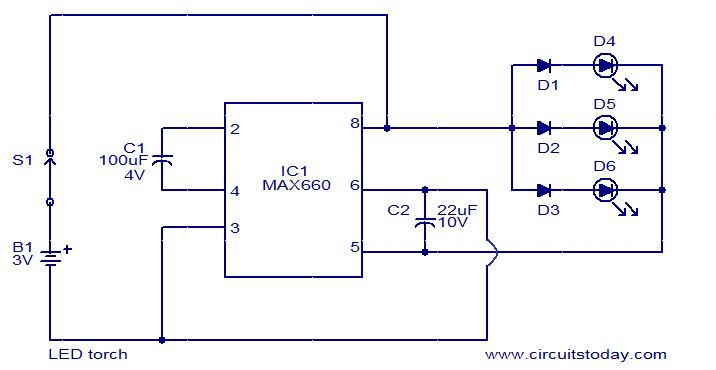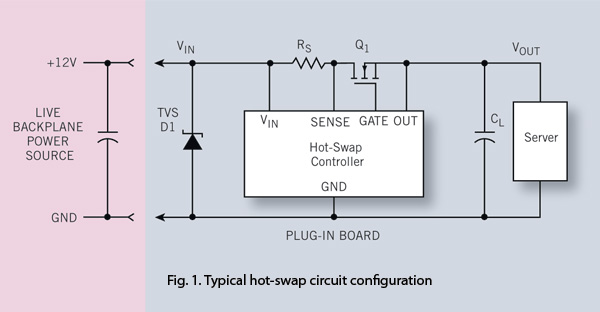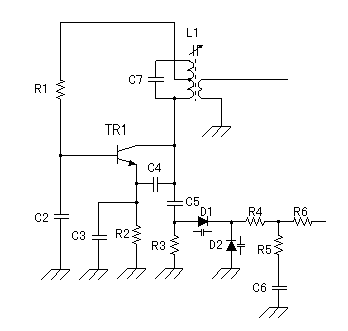
simple led torch circuit

This circuit is a simple LED torch utilizing the MAX660 integrated circuit from MAXIM semiconductors. The MAX660 is a CMOS monolithic voltage converter IC capable of driving three bright white LEDs connected in parallel to output pin 8 of the IC. The circuit is designed for efficient battery usage, and the switch S1 functions as a push-to-ON switch.
The LED torch circuit operates by converting a lower voltage from the power source, typically a battery, into a higher voltage suitable for powering the LEDs. The MAX660 IC is selected for its efficiency and ability to maintain a stable output voltage, ensuring that the LEDs emit a consistent brightness. The parallel configuration of the LEDs allows for uniform light distribution and enhances the overall illumination.
The circuit design includes essential components such as input and output capacitors that stabilize the voltage levels and minimize ripple. The choice of capacitors should be based on their voltage ratings and capacitance values, which will influence the performance of the voltage conversion. The input capacitor, usually placed close to the IC, helps to smooth the input voltage, while the output capacitor serves to stabilize the output voltage and reduce noise.
When the switch S1 is activated, it completes the circuit, allowing current to flow from the battery to the MAX660 IC. The IC then boosts the voltage to the required level and drives the three LEDs. The use of a push-to-ON switch provides a simple and user-friendly interface for operating the torch.
For optimal performance and battery life, it is essential to select LEDs with suitable forward voltage ratings that match the output voltage of the MAX660. Additionally, the circuit should be designed to minimize power loss through careful layout and component selection. This includes using low-resistance traces and ensuring that the components are rated for the expected current and voltage levels.
In summary, this LED torch circuit demonstrates a practical application of the MAX660 voltage converter IC, providing an efficient and reliable lighting solution with extended battery life.This is a simple LED torch circuit based on IC MAX660 from MAXIM semiconductors. The MAX 660 is a CMOS type monolithic type voltage converter IC. The IC can easily drive three extra bright white LEDs. The LEDs are connected in parallel to the output pin 8 of the IC. The circuit has good battery life. The switch S1 can be a push to ON switch. 🔗 External reference
The LED torch circuit operates by converting a lower voltage from the power source, typically a battery, into a higher voltage suitable for powering the LEDs. The MAX660 IC is selected for its efficiency and ability to maintain a stable output voltage, ensuring that the LEDs emit a consistent brightness. The parallel configuration of the LEDs allows for uniform light distribution and enhances the overall illumination.
The circuit design includes essential components such as input and output capacitors that stabilize the voltage levels and minimize ripple. The choice of capacitors should be based on their voltage ratings and capacitance values, which will influence the performance of the voltage conversion. The input capacitor, usually placed close to the IC, helps to smooth the input voltage, while the output capacitor serves to stabilize the output voltage and reduce noise.
When the switch S1 is activated, it completes the circuit, allowing current to flow from the battery to the MAX660 IC. The IC then boosts the voltage to the required level and drives the three LEDs. The use of a push-to-ON switch provides a simple and user-friendly interface for operating the torch.
For optimal performance and battery life, it is essential to select LEDs with suitable forward voltage ratings that match the output voltage of the MAX660. Additionally, the circuit should be designed to minimize power loss through careful layout and component selection. This includes using low-resistance traces and ensuring that the components are rated for the expected current and voltage levels.
In summary, this LED torch circuit demonstrates a practical application of the MAX660 voltage converter IC, providing an efficient and reliable lighting solution with extended battery life.This is a simple LED torch circuit based on IC MAX660 from MAXIM semiconductors. The MAX 660 is a CMOS type monolithic type voltage converter IC. The IC can easily drive three extra bright white LEDs. The LEDs are connected in parallel to the output pin 8 of the IC. The circuit has good battery life. The switch S1 can be a push to ON switch. 🔗 External reference





